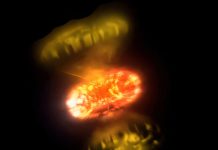
Astronomers have picked up radio signals from comet 12P/Pons-Brooks, offering new insights into the mysterious outbursts and icy composition of this spectacular space visitor.
The discovery was made by a team led by the Shanghai Astronomical Observatory using the Tianma Radio Telescope in China.
The findings, published in Astronomy & Astrophysics, include the most distant radio detection of ammonia ever found in a Halley-type comet.
Comet 12P/Pons-Brooks, known for its dramatic flares and green glow, travels around the sun once every 71 years.
Since its discovery in 1812, it has repeatedly surprised astronomers with sudden bursts of brightness—known as outbursts—whose causes remain unclear.
During its most recent return in 2024, the comet once again erupted multiple times, providing an excellent opportunity for scientists to study what triggers these events.
Comets like 12P are often described as “frozen time capsules” from the early solar system.
They contain ices and dust left over from the time the planets were formed, about 4.6 billion years ago.
When a comet approaches the sun, the heat causes these ices to vaporize, releasing gas and dust that form the glowing tail and coma.
Because these materials have remained mostly unchanged for billions of years, studying them helps scientists understand the conditions of the early solar system.
From late 2023 to early 2024, the research team used the Tianma Telescope to observe 12P at multiple radio frequencies.
In one frequency range, called the L-band, they detected signals from hydroxyl (OH) molecules, which are created when sunlight breaks apart water vapor. Using computer models, the team calculated how much water the comet was releasing before and after each outburst.
They discovered that at a distance of about 1 astronomical unit from the sun (roughly the same distance as Earth), 12P can release more than 5 tons of water per second—twice as much during its brightest outbursts.
That makes it one of the most active comets ever studied.
In another frequency range, known as the K-band, the team made an even more remarkable discovery: the first-ever detection of ammonia gas (NH₃) from a Halley-type comet using radio waves.
This detection, confirmed with high confidence, represents the most distant observation of ammonia molecules ever made in such a comet.
The researchers found that 12P’s ammonia levels are unusually high compared to most other comets. Since ammonia turns to gas at relatively low temperatures, its abundance could help explain why 12P experiences frequent and powerful outbursts.
The findings provide valuable clues about how comets release gas and evolve over time. They also show how advanced radio telescopes like Tianma can reveal details about the chemistry of distant icy bodies.
By tracing molecules such as water and ammonia, scientists are piecing together how these ancient objects continue to change—and what they can teach us about the early days of our solar system.
Source: Chinese Academy of Sciences.



